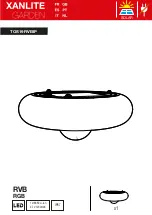
2
ALWAYS CONSULT A PHYSICIAN BEFORE PERFORMING ANY KIND OF PHYSICAL ACTIVITY
Adequate overhead clearance is essential. A minimum of 24ft from ground level is recommended. Provide
clearance for wires, tree limbs, and other possible hazards.
Lateral clearance is essential. Place the trampoline away from walls, structures, fences, and other play
areas.
Maintain a clear space of 2.5 meters on all sides of the trampoline. For safe use of the trampoline, please
be aware of the following when selecting a place for your trampoline:
Place the trampoline on a level surface before use; illumination may be required for shady areas and
indoor areas.
Secure the trampoline against unauthorized and unsupervised use.
Remove any obstructions from beneath the trampoline.
The owner and supervisors of the trampoline are responsible to make all users aware of practices
specified in the use instructions.
Do not attempt or allow somersaults. Landing on the head or neck can cause serious injury, paralysis or
death, even when landing in the middle of the bed.
Do not allow more than one person on the trampoline. Use by more than one person at the same time can
result in serious injury.
Use trampoline only with mature, knowledgeable adult supervision.
For additional information concerning the trampoline equipment, contact the manufacturer.
Only for domestic use and outdoor use.
Not suitable for children under 3 years. Small parts. Choking hazard. Long cord. Strangulation hazard.
Maximum weight of the user shall not exceed 198lbs (90kg) for 12FT.
Maximum weight of the user shall not exceed 220lbs (100kg) for 15FT.
Only one user. Collision hazard.
Adult supervision required.
No
somersaults.
Always jump in the middle of the mat.
All nuts and bolts must be checked for tightness and if necessary must be retightened.
All spring-loaded (pit pin) joints must be checked to see that they are still intact and cannot become
dislodged during play.
Check all coverings for bolts and sharp edges and replace them if necessary.
If self-locking nuts are used, it should be noted that these are only suitable for one assembly and must
therefore be replaced.
Information regarding the expiry of the enclosure.
Trampolines over 20in. (51 cm) tall are not recommended for use by children under 6 years of age.
Inspect the trampoline before each use. Make sure the frame padding is correctly and securely positioned.
Replace any worn, defective, or missing parts.
Climb on and off the trampoline. It is a dangerous practice to jump from the trampoline to the floor or
ground when dismounting, or to jump onto the trampoline when mounting. Do not use the trampoline as a
springboard onto other objects.
Stop bounce by flexing knees as feet come in contact with the trampoline bed. Learn this skill before
attempting others.
Learn fundamental bounces and body positions thoroughly before trying more advanced skills. A variety of
trampoline activities can be carried out by performing the basic fundamentals in various series and
combinations, performing one fundamental after another, with or without feet bounces between them.
Avoid bouncing too high. Stay low until bounce control and repeated landing in the center of the trampoline
can be accomplished. Control is more important than height.
Focus eyes on the trampoline. This will help control bounce.
Avoid bouncing when tired. Keep turns short.
Properly secure the trampoline when not in use. Protect it against unauthorized use. If a trampoline ladder
is used, the supervisor should remove it from the trampoline when leaving the area to prevent
unsupervised access by children under 6 years of age.
NO MORE THAN ONE
PERSON AT A TIME ON THE
TRAMPOLINE!
MULTIPLE JUMPERS
INCREASE THE RISK OF
INJURY SUCH AS BROKEN
HEAD, NECK, LEG OR BACK.
PARALYSIS OR DEATH CAN
RESULT IF YOU LAND ON
YOUR HEAD OR NECK!
DO NOT PERFORM
SOMERSAULTS (FLIPS) AS
THIS WILL INCREASE YOUR
CHANCES OF LANDING ON
YOUR HEAD OR NECK!
Summary of Contents for 201806
Page 13: ...12 Trampoline Assembly STEP 1...
Page 14: ...13 STEP 2 Note Repeat step 2 to assemble five more leg sections...
Page 15: ...14 STEP 3 FOR 12FT...
Page 16: ...15 STEP 3 1 FOR 15FT...
Page 17: ...16 STEP 4 Note Repeat step 4 to assemble five more Top Rail and Leg...
Page 18: ...17 STEP 5 NOTE...
Page 28: ...27 STEP 7...
Page 29: ...28 STEP 8...
Page 30: ...29 STEP 9 G C C C C D G C C C C C D...
Page 31: ...30 STEP 10...
Page 32: ...31 STEP 11...
Page 33: ...32 STEP 12...




































